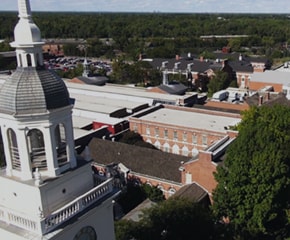
Henry Ford: Village Industries
9 artifacts in this set
Map Showing Ford Motor Company Village Industries in Southeast Michigan and Ontario, Canada, 1942
Photographic print
In the 1920s and '30s, Henry Ford set up small-scale factories to supply Ford with needed tools and vehicle parts. He scattered these "Village Industries" throughout southeast Michigan usually along rivers. Ford employed local residents -- ideally farmers who could maintain their farms when not working at the factory. This map shows the factories Ford had created by 1942.
Construction of Ford Motor Company Hydro Electric Station in Saline, Michigan, 1935
Photographic print
In the early 1920s, Henry Ford began locating small hydroelectrically powered plants in rural southeast Michigan. These "Village Industries" employed local people who could maintain farms while working at the factory. One plant, constructed in Saline in the mid-1930s, operated until 1947. During World War II, workers here processed soybean oil for paints and plastics and machined parts for Pratt & Whitney engines.
Women Workers at Phoenix Mill Plant during Changeover from Automobile Parts Production to Defense Work, Plymouth, Michigan, 1942
Photographic print
In the 1920s and '30s, Henry Ford set up small-scale factories throughout southeast Michigan. These "Village Industries" supplied Ford with tools and vehicle parts. Employees at his Phoenix Mill factory made electrical parts and voltage regulators. Most of this factory's employees were women. This photo was taken in 1942 during a period of changeover from automotive parts production to defense work.
Ford Village Industries Nankin Mills Plant, 1932
Photographic print
In the early 1920s, Henry Ford began locating small hydroelectrically powered plants in rural southeast Michigan. These "Village Industries" employed local people who could maintain farms while working at the factory. This Westland-area plant opened in an old flour mill in 1921. Workers here produced tool and die work and performed special engraving and defense experiment work during World War II.
Ford Motor Company Valve Plant, Northville, Michigan, July 15, 1935
Photographic print
In the 1920s and '30s, Henry Ford set up small-scale factories throughout southeast Michigan. These "Village Industries" employed local residents and supplied Ford with tools and vehicle parts. The factory at Northville started operations in 1920 and made engine valves. The Northville factory remained productive into the early 1980s, long after Henry's other Village Industries mills had closed.
Ford Motor Company Gauge Plant, Northville Township, Michigan, 1936
Photographic print
In the 1920s and '30s, Henry Ford set up small-scale factories throughout southeast Michigan. These "Village Industries" supplied Ford with tools and vehicle parts. The factory at Waterford -- one of many scattered along the Middle Rouge River basin -- opened in 1925. Its employees made precision inspection gauge blocks. The plant remained open until the late 1950s.
Newspaper, "The Dearborn Independent, Ford Confidence Edition, Industrial Section," 1938
Newspaper
In 1938, the Dearborn Independent published a special section highlighting Ford Motor Company's successes during the Great Depression. The cover image represented a longtime interest of Henry Ford's: the mutual relationship between industry and agriculture. Henry Ford had owned the Dearborn Independent from 1919 to 1927, and he had used it to publish notoriously anti-Semitic editorials and articles.
Ford News, Bound Volume for 1931-1932
Serial (Publication)
Ford Motor Company published Ford News from 1920 to 1942. The magazine kept employees and dealers informed on the automaker's products and activities. Each issue contained general-interest stories as well. The August 1931 edition included a supplement on Henry Ford's Village Industries -- small-scale factories in southeast Michigan that supplied parts, tools, and equipment to larger Ford plants.
Hayden Mills Hydroelectric Plant, Tecumseh, Michigan, 1936
Photographic print
In the 1920s and '30s, Henry Ford set up small-scale factories throughout southeast Michigan. These "Village Industries" employed local residents -- ideally farmers who could maintain their farms when not working at the factory -- and supplied Ford with tools and vehicle parts. At Hayden Mills in Tecumseh, Michigan, employees cleaned, packed, and stored soybeans -- a crop used by Ford to make paints and plastics.
This is user-generated content and does not reflect the views of The Henry Ford.


